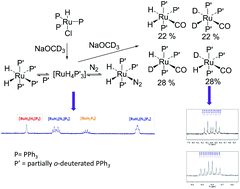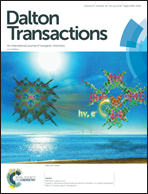Insight into the mechanism of decarbonylation of methanol by ruthenium complexes; a deuterium labelling study†‡
Abstract
In the reaction of [RuHClP3] (P = PPh3) with NaOMe in methanol, the product is [RuH2(CO)P3]. Short reaction times show that the final product is formed through [RuH4P3] as the major intermediate. Using NaOCD3 in CD3OD, the first formed product is [RuH4P′3] (P′ is PPh3 partially deuterated in the ortho positions of the aromatic rings). Further reaction leads to a mixture of [RuHnD2−n(CO)P3] (n = 0, 22%; n = 1, 2 isomers each 28%; n = 2, 22%). Mechanistic aspects of both steps of the reaction are explored and, together with previously published calculations, they provide definitive mechanisms for both dehydrogenation and decarbonylation in these interesting systems.



 Please wait while we load your content...
Please wait while we load your content...